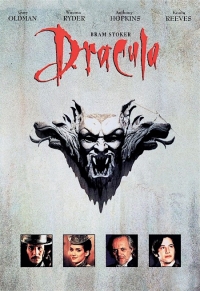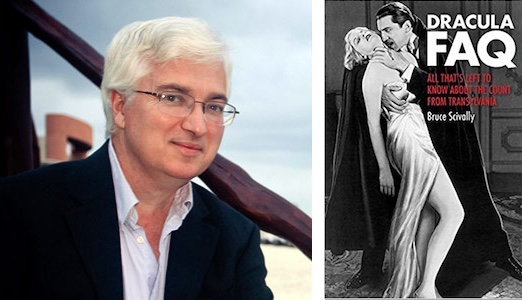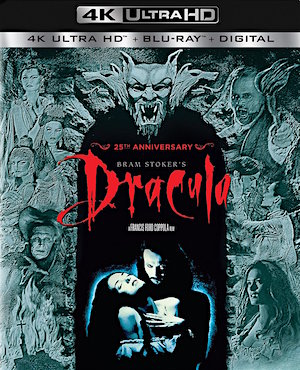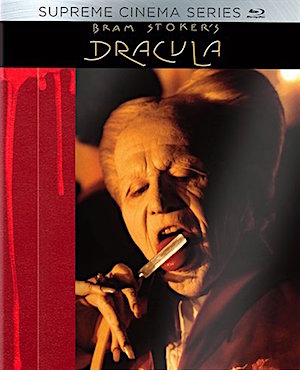Bruce Scivally is the author of Dracula FAQ: All That’s Left to Know about the Count from Transylvania (Backbeat, 2015). His other books include Booze, Bullets & Broads: The Story of Matt Helm, Superspy of the Mad Men Era (Henry Gray, 2013), Billion Dollar Batman: A History of the Caped Crusader on Film, Radio and Television from 10¢ Comic Book to Global Icon (Henry Gray, 2011), Superman on Film, Television, Radio & Broadway (McFarland, 2006), and (with John Cork) of James Bond: The Legacy (Abrams, 2002). As well, he has written and produced numerous documentaries and featurettes that have appeared as supplemental material on LaserDisc, DVD and Blu-ray Disc, including several of the Charlie Chan, James Bond, and Pink Panther releases. He is Vice President of New Dimension Media of Chicago, Illinois.
Michael Coate (The Digital Bits): How do you think Bram Stoker’s Dracula should be remembered on its 25th anniversary?
Bruce Scivally: Bram Stoker’s Dracula was a game changer. It was unlike any Dracula film that had come before, and established a tone and style that redefined cinematic vampires. Screenwriter James V. Hart returned to Stoker’s original novel for inspiration, but at the same time borrowed ideas from Dan Curtis’ 1973 TV movie (also titled Bram Stoker’s Dracula) and the vampire novels of Anne Rice. From Curtis (and teleplay writer Richard Matheson), he borrowed the idea that Mina is a reincarnation of Dracula’s lost love from centuries before. From Anne Rice, he borrowed the notion that the vampire doesn’t merely turn into a bat, but rather transforms into a monstrous human-bat hybrid, like the winged demons from Gustave Dore’s illustrations for Dante’s Inferno (just Google “The Inferno, Canto 22 – Gustave Dore”). Add to that costume designer Eiko Ishioka’s inspirations — Dracula’s Samurai-inspired red armor, his scarlet silk kimono, his sunglasses, not to mention Mina’s gowns and Lucy’s white lace ruffled burial gown, and a score by Wojciech Kilar that goes from pulse-pounding martial music to lush romanticism, and the use of old-fashioned in-camera effects, and the entire film seems at once outmoded and futuristic. In its way, it was the first Steampunk film, and every vampire movie since has been influenced by its style.
Coate: What did you think of the film when you (first) saw it?
Scivally: Bram Stoker’s Dracula is one of those films that I disliked on first viewing, but have come to appreciate over time, which is an indication of how much it was ahead of its time. Coppola’s operatic approach to the material — rather than the more traditionally Gothic take of the Universal and Hammer horror films, or the 1979 Dracula starring Frank Langella (still my personal favorite) — was more than a fresh approach; it was absolutely revolutionary. Knowing more now about the backstory of the film and the intent of the filmmakers, I can appreciate it for its out-of-the-box thinking; at the time, I was too entrenched in the tried-and-true vampire formula to get it.
Coate: In what way was Francis Coppola an ideal choice to direct Bram Stoker’s Dracula, and where does the film rank among his body of work?
Scivally: Coppola was ideal to direct Bram Stoker’s Dracula because it was one of his favorite novels — he used to read it to his young charges when he worked at a summer camp in his youth — but he was enough of an iconoclast to think way outside the box instead of falling into the tried-and-true vampire/horror movie tropes. It’s not his greatest film — how can you top The Godfather, The Conversation or Apocalypse Now? — but it came after a string of films that were box-office disappointments: Gardens of Stone, Tucker: The Man and His Dream, and the lamentable Godfather III. Coppola could have made a straightforward horror film out of Bram Stoker’s Dracula, but he didn’t; he made something fresh and exciting, not just another scary movie but rather a Coppola film, and a pretty extraordinary one, at that.
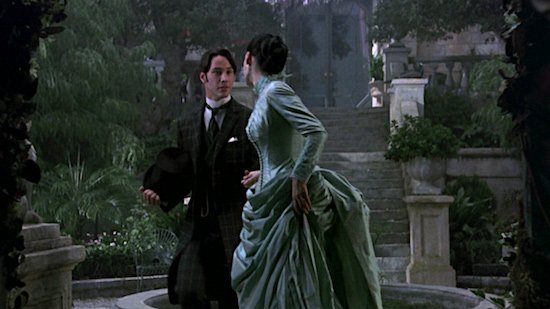
Coate: Is Bram Stoker’s Dracula a significant (horror) film in any way?
Scivally: Bram Stoker’s Dracula is significant in the way that The Exorcist and The Shining were significant, in showing that a horror story can be worthy of an A-list cast and production values, and that a truly imaginative filmmaker can take even a story as hoary as Dracula and give it a new lustre.
Coate: They’ve been making Dracula movies since about as long as they’ve been making movies. What is it about the character and concept that storytellers find so alluring?
Scivally: Dracula was written at the end of the Victorian era, which we think of as a buttoned-down, sexually repressed time. Yet the novel seethes with sexuality and sexual symbolism (even the vampire’s bite is, after all, a penetration), which makes it feel very modern today. In addition, there’s a theme of fear of foreign invaders (sound familiar?) and a breaking down of the old status quo (Make Britain Great Again!); even Mina is a representation of what was then called "the new woman," i.e., an independent woman who would work in an office, like her husband, rather than merely stay home and take care of the children, so it can also be seen as a tale of female empowerment. These ideas are just as relevant now as they were when the book was published in 1897. In addition, vampires and movies are a perfect match. Movies, with their visual trickery, can show vampires transforming into bats, wolves and mist. And even the very notion of cinema itself is vampiric, capturing the essence of performers who then remain ever youthful, never aging, and who, in this digital age, can be summoned up anytime to haunt us anew with their ghostly presence.
Coate: In what way was Gary Oldman a memorable or effective Dracula? And what did you think of the other key performances in the film? Do they elevate or hinder the quality of the film?
Scivally: One of the earliest films I remember seeing is the 1931 Dracula starring Bela Lugosi, which was pretty scary to me when I was five years old. In my teens, I discovered Christopher Lee’s more feral interpretation of the character in the Hammer horror films, and enjoyed Jack Palance’s take in the aforementioned Dan Curtis TV movie. My favorite version of the story remains the 1979 Dracula scripted by W.D. Richter, with Frank Langella — fresh off reviving the character on Broadway — creating a more sensual, Byronic vampire. In a way, Gary Oldman combines all of those earlier performances into one. He has an even thicker accent than Lugosi, exhibits the savage fierceness of Lee and Palance, and is even more Byronic than Langella. I don’t think there has ever been an actor before or since who portrayed such a wide range of emotions as Dracula. Oldman’s performance is a highlight of the film, and Winona Ryder is quite good in a role that she hoped would present her as a more adult actor after a string of emo teen roles. And then there’s Keanu Reeves... I like Keanu Reeves. I think he’s a good actor, and I think he’s terrific in the recent John Wick films. But in Bram Stoker’s Dracula, Reeves seems woefully out of place. His poor on-again, off-again English accent is distracting, and his discomfort in the role manifests itself in a performance so wooden it nearly puts a lethal stake through the heart of the film. Coppola cast Reeves because he wanted a hot, young actor to play Jonathan Harker; ‘tis a pity he didn’t choose a hot, young British actor, like, say, Rupert Graves. Then the film might have been damn near perfect.
Coate: How does Coppola’s Dracula film compare to past and more recent interpretations?
Scivally: Coppola’s version of Dracula is one of the most lush ever committed to film, and it’s an interpretation of the story that stresses romance over horror even more so than the Palance or Langella versions. It’s the film to see if you want an emotionally overwrought, visually sumptuous feast. In musical terms, Lugosi’s film is a concerto, Langella’s a ballet, and Coppola’s is grand opera. And I think it’s significant that in that sentence, I’ve identified the first two examples by their actors, and the third by its director. The film may as well have been officially titled Francis Ford Coppola’s Dracula, because it so unmistakably bears the stamp of its director.
Coate: What is the legacy of Bram Stoker’s Dracula?
Scivally: As mentioned before, the legacy of Bram Stoker’s Dracula is that it created a host of new vampire film tropes, like retractable fangs, vampires turning into literal bat-men, and a Steampunk aesthetic. It also created a renewed interest in Bram Stoker’s literary creation, so that the following decades have seen more Dracula movies, a Dracula TV series, and a gentle spoofing of Coppola’s Dracula in both The Simpsons and the New Zealand mockumentary What We Do in the Shadows. In short, Coppola pumped new blood into the vampire film.
Coate: Thank you, Bruce, for sharing your thoughts about Bram Stoker’s Dracula on the occasion of its 25th anniversary.
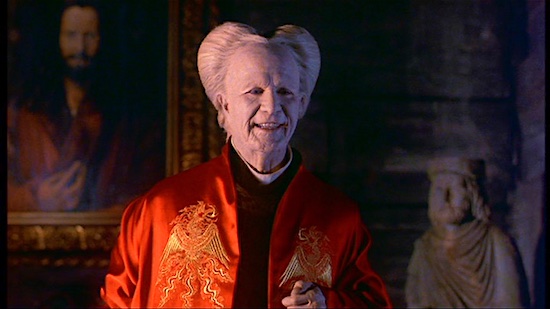
IMAGES
Selected images copyright/courtesy American Zoetrope, Columbia Pictures, Columbia TriStar Home Entertainment, Osiris Films, Sony Pictures.
- Michael Coate
Michael Coate can be reached via e-mail through this link. (You can also follow Michael on social media at these links: Twitter and Facebook)


